Unleashing Your Creativity with Pottery
Have you ever felt that *itch* to create something beautiful with your hands? Pottery is not just about molding clay; it's a journey into your own creativity. Imagine transforming a lump of clay into a stunning vase or a unique bowl that tells a story. Pottery allows you to express yourself in ways that are both tangible and deeply personal. It’s like painting, but with a three-dimensional canvas that you can touch, feel, and use. The beauty of pottery lies in its ability to connect us to our inner artist, helping us to unleash our imagination and explore new ideas.
As you dive into the world of pottery, you'll find that it’s more than just a hobby; it’s a *transformative experience*. When you knead the clay, you’re not just working with your hands, but also with your heart and mind. Each piece you create is a reflection of your personality, your mood, and your artistic vision. Whether you're a complete novice or someone with a bit of experience, the journey of pottery can be incredibly fulfilling. It invites you to embrace imperfections and celebrate the unique qualities of each creation.
But why pottery? What makes it such a powerful medium for creativity? For one, it offers endless possibilities. You can experiment with different types of clay, explore various techniques, and even play around with colors and textures. The only limit is your imagination! And let’s not forget the *therapeutic benefits* of working with clay. Many find that the repetitive motions involved in pottery help to soothe the mind, reduce stress, and promote mindfulness. It’s like a form of meditation where your hands do the talking.
In this article, we will explore the essential elements of pottery, from understanding the basics to advanced techniques. We’ll delve into the tools you need, the therapeutic aspects of the craft, and how to find inspiration for your creations. Whether you’re looking to start a new hobby or deepen your existing skills, this guide will equip you with the knowledge you need to make the most of your pottery journey. So, roll up your sleeves, and let’s get our hands dirty!
- What type of clay is best for beginners? Earthenware is often recommended for beginners due to its workability and lower firing temperature.
- Do I need a potter's wheel to start? No, many techniques can be done by hand, such as pinch pots and coil building.
- How can I find a pottery class near me? Check local community centers, art schools, or online platforms for classes and workshops.
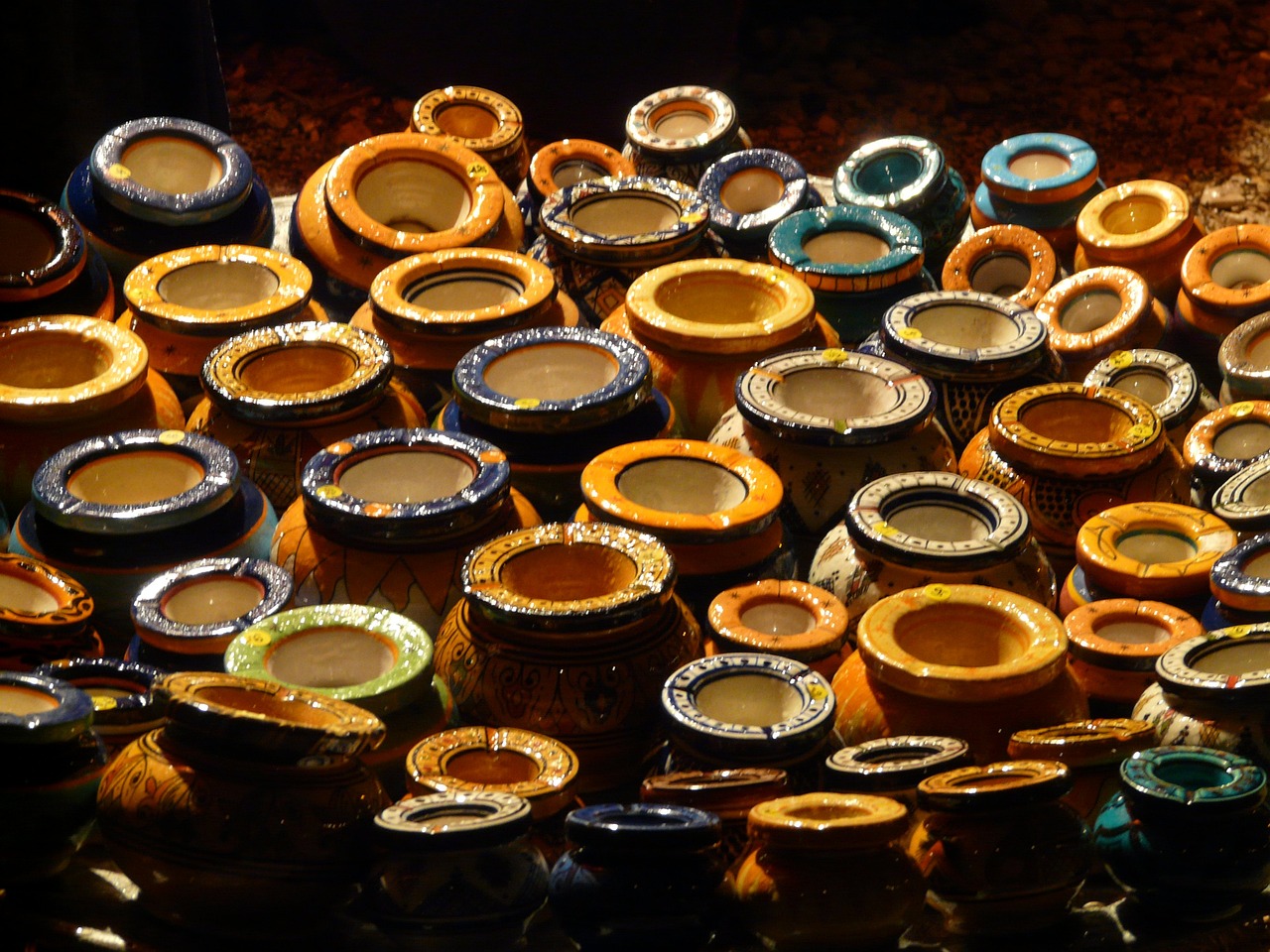
Understanding the Basics of Pottery
When you first dip your hands into the world of pottery, it can feel like stepping into a magical realm where creativity knows no bounds. Pottery is not just about molding clay; it’s about expressing yourself, your emotions, and your unique vision. To start your journey, it's essential to understand the fundamental concepts that lay the groundwork for your artistic endeavors. Let's explore the different types of clay, essential tools, and the basic techniques that every beginner should master.
First off, let's talk about types of clay. There are several varieties, but the most common ones include:
- Earthenware: This is a low-fire clay that is easy to work with, making it perfect for beginners. It’s porous and often used for decorative pieces.
- Stoneware: A mid to high-fire clay that is durable and non-porous. It’s great for functional pottery like dishes and mugs.
- Porcelain: Known for its fine texture and translucence, porcelain is a high-fire clay that requires more skill to handle but can produce stunning results.
Understanding these types of clay is crucial because each one behaves differently when fired and can influence the final outcome of your piece. Now, let’s move on to the essential tools you’ll need to get started. While it might seem overwhelming at first, having the right tools can make all the difference in your pottery journey. Here’s a quick rundown:
| Tool | Purpose |
|---|---|
| Potter's Wheel | Used for shaping clay into symmetrical forms. |
| Wire Cutter | Helps to slice off pieces of clay from larger blocks. |
| Ribs and Scrapers | Used for smoothing and shaping the surface of your pottery. |
| Sponges | Essential for adding moisture and smoothing out surfaces. |
| Tools for Decoration | Including stamps, brushes, and carving tools for adding unique designs. |
Once you have your clay and tools, it's time to dive into the basic techniques. Mastering these will set the foundation for your pottery skills. You’ll want to familiarize yourself with:
- Pinch Pots: A simple technique where you pinch the clay into shape, allowing for a personal touch.
- Coil Building: Rolling out coils of clay and stacking them to create larger forms.
- Slab Construction: Using flat pieces of clay to build walls and structures, perfect for boxes or plates.
Each method offers a different way to express your creativity, and as you practice, you’ll discover your preferences and style. Remember, pottery is as much about the process as it is about the final product. So, don’t be afraid to make mistakes; they’re often the best teachers!
In conclusion, understanding the basics of pottery is your first step towards unleashing your creative potential. With the right knowledge of clay types, essential tools, and foundational techniques, you’re well on your way to creating beautiful ceramic pieces that reflect your individuality. So, roll up your sleeves, get your hands dirty, and let the clay guide you on this exciting journey!
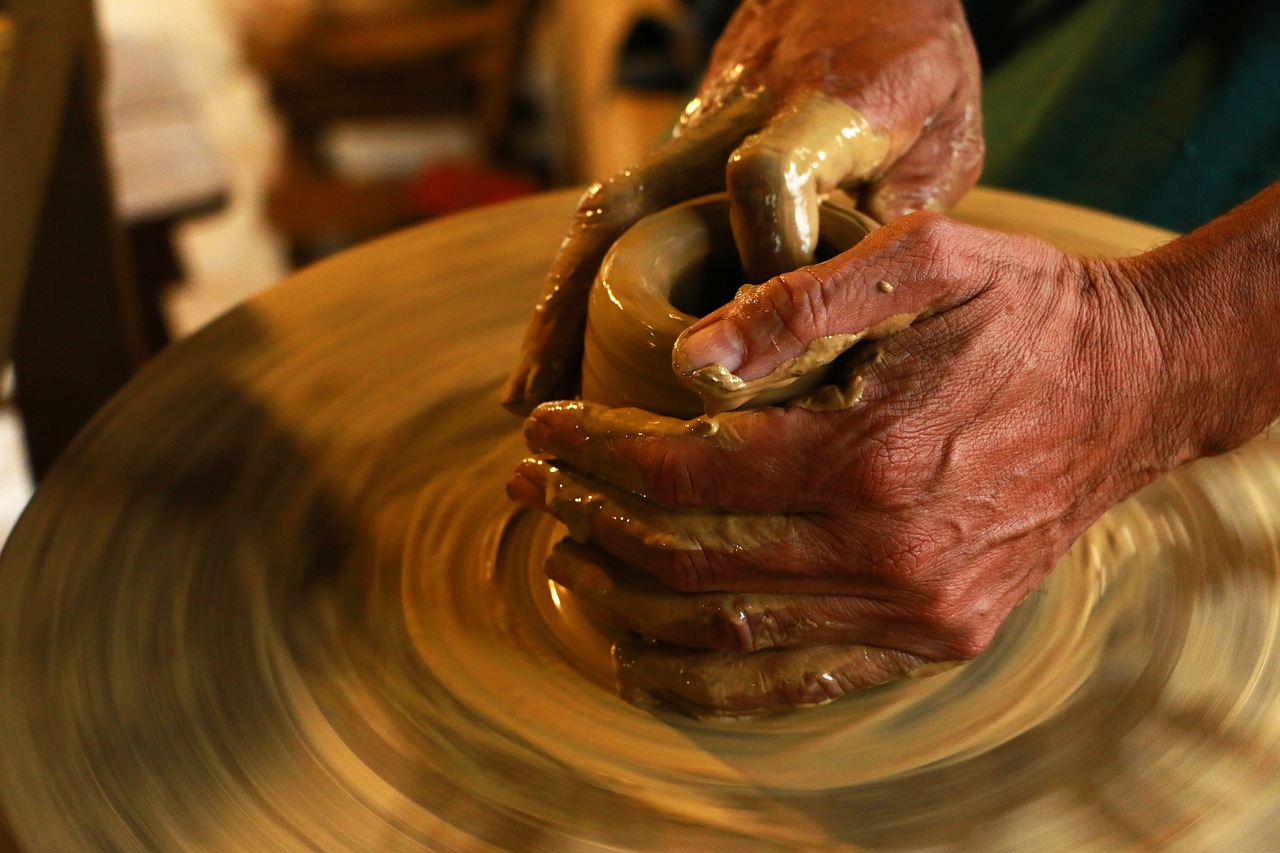
The Therapeutic Benefits of Pottery
Have you ever felt the stress of the world melting away as you sink your hands into a lump of clay? Pottery is not just an art form; it's a therapeutic journey that can help you reconnect with your inner self. Engaging with clay allows you to enter a state of flow, where your mind can wander freely, and creativity flows effortlessly. This tactile experience promotes mindfulness, encouraging you to focus on the present moment and escape the chaos of daily life.
When you mold clay, you're not just shaping a physical object; you're also shaping your emotional landscape. The act of creating can be incredibly cathartic, allowing you to express feelings that might be difficult to articulate in words. Whether you're crafting a simple bowl or an intricate sculpture, pottery provides a medium for self-expression that can lead to personal insights and emotional release.
Moreover, the repetitive motions involved in pottery, such as kneading, rolling, and shaping, can have a meditative effect. This process can significantly reduce stress levels and promote relaxation. As you immerse yourself in the rhythm of working with clay, you may find that your worries begin to dissipate, replaced by a sense of calm and accomplishment.
Research has shown that engaging in creative activities like pottery can lead to improved mental health. Here are some therapeutic benefits that pottery can offer:
- Mindfulness: The focus required for pottery encourages a meditative state, helping to clear the mind of distractions.
- Stress Reduction: The physical act of working with clay can lower cortisol levels, alleviating stress.
- Emotional Expression: Pottery provides a safe space to explore and express emotions, fostering emotional healing.
- Boosted Self-Esteem: Completing a pottery project can enhance feelings of accomplishment and self-worth.
In addition to these benefits, pottery can also foster a sense of community. Many pottery studios offer classes and workshops, providing opportunities to connect with others who share your passion. This social aspect can lead to new friendships and a supportive network, further enhancing the therapeutic experience.
So, if you're looking for a way to unwind and tap into your creative side, consider picking up some clay. You might be surprised at how much joy and healing can come from simply getting your hands dirty. Pottery isn't just about creating beautiful objects; it's about nurturing your soul and finding peace in a chaotic world.
Q: Can anyone try pottery, or do you need prior experience?
A: Absolutely! Pottery is accessible to everyone, regardless of experience. Beginners are welcome in most classes, and instructors are there to guide you through the basics.
Q: What materials do I need to start pottery?
A: To begin, you'll need some clay, basic tools (like a sponge, knife, and wire cutter), and a workspace. Many studios provide these materials for beginners.
Q: How does pottery help with stress relief?
A: The hands-on nature of pottery encourages mindfulness and focus, allowing you to escape from daily stressors and engage in a calming, creative activity.
Q: Is pottery a solitary activity?
A: While you can certainly enjoy pottery alone, many find joy in communal classes and workshops, where they can share ideas and techniques with others.

Essential Tools for Pottery Making
When diving into the world of pottery, having the right tools at your disposal is crucial. Think of these tools as your trusty sidekicks on your creative journey. They can help transform a simple lump of clay into stunning works of art. So, what are the essential tools you need to get started? Let’s break it down!
First and foremost, you’ll need a good quality potter's wheel if you plan to explore wheel-throwing. This is where the magic happens! A wheel can be electric or kick-driven, and it allows you to shape your clay effortlessly. If you’re more into hand-building, don’t worry! There are plenty of other tools that can help you create beautiful pieces without a wheel.
Next up, let’s talk about clay. There are various types, each with its own unique properties. For beginners, earthenware is often recommended because it’s easy to work with. However, stoneware and porcelain are also popular choices once you gain some experience. Remember, the type of clay you choose will affect the final outcome of your project.
Now, let’s not forget about the essential hand tools. These include items like:
- Wire cutters - Perfect for slicing off chunks of clay or removing your finished piece from the wheel.
- Pottery ribs - These handy tools help smooth and shape your clay as you work.
- Sculpting tools - Great for adding details and textures to your creations.
In addition to these, a good rolling pin is a must-have for hand-building projects. It helps you flatten out your clay evenly, making it easier to create slabs for your designs. Speaking of slabs, a slab roller can be a game-changer if you plan on making a lot of slab-built pieces.
When it comes to glazing, having a set of glazing brushes and sponge applicators will be beneficial. These tools allow you to apply glazes evenly and creatively. Plus, don’t forget about a sifter for your glaze materials. This ensures that your glazes are smooth and free from lumps, which can ruin the finish of your pottery.
Finally, let’s touch on firing equipment. If you’re serious about pottery, investing in a kiln is essential. This is where your pieces will undergo the transformative process of firing, turning them from fragile clay into durable ceramics. If a kiln isn’t feasible right now, many local studios offer kiln services for a fee.
In summary, the essential tools for pottery making include:
| Tool | Purpose |
|---|---|
| Potter's Wheel | Shaping clay for wheel-throwing |
| Clay | Material for creating pottery |
| Hand Tools | Sculpting and shaping clay |
| Rolling Pin | Flattening clay for slabs |
| Glazing Brushes | Applying glazes evenly |
| Kiln | Firing pottery to harden it |
With these tools in hand, you’re well on your way to unleashing your creativity in pottery. Remember, each tool plays a vital role in your artistic process, so take the time to learn how to use them effectively. Happy potting!
Q: Do I need a potter's wheel to start pottery?
A: No, you can start with hand-building techniques. A potter's wheel is great for those who want to explore wheel-throwing later on.
Q: What type of clay is best for beginners?
A: Earthenware is often recommended for beginners due to its workability and forgiving nature.
Q: Can I use regular kitchen tools for pottery?
A: While some kitchen tools can work in a pinch, investing in proper pottery tools will yield better results.
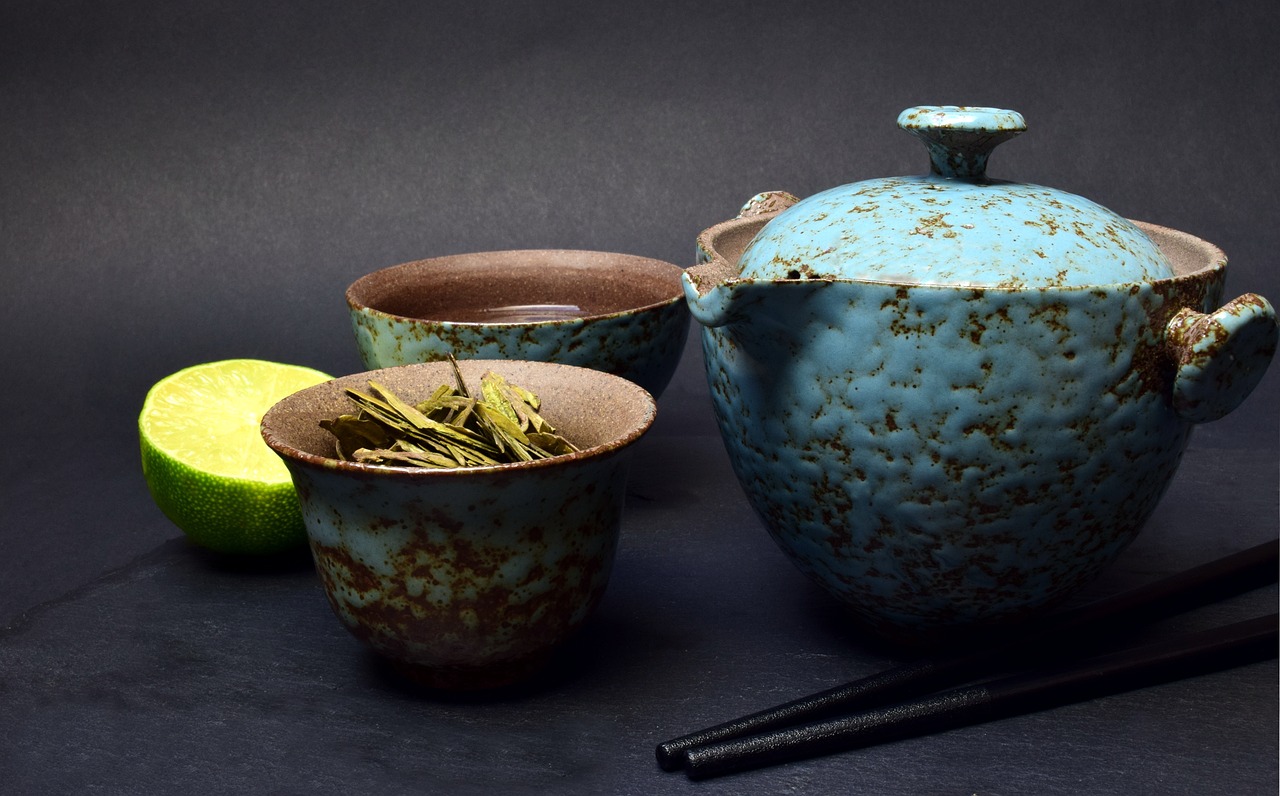
Hand-Building Techniques
When it comes to pottery, hand-building techniques are like the foundational strokes of a painting—they set the stage for creativity and expression. These methods allow you to mold and shape clay without the need for a potter's wheel, making pottery accessible to everyone, regardless of skill level. Whether you're a total newbie or someone looking to expand your repertoire, mastering hand-building techniques can be incredibly rewarding.
One of the most popular hand-building methods is the pinch pot technique. This technique is as straightforward as it sounds—start by taking a ball of clay, then use your fingers to pinch and shape it into a pot. The beauty of pinch pots lies in their organic, imperfect forms, which can be customized to your liking. Have you ever felt the satisfaction of creating something entirely with your hands? That’s the magic of pinch pots!
Next up is the coil building technique. Imagine stacking rings on your fingers, but instead, you’re stacking coils of clay to build up the walls of your piece. This method allows for greater height and volume, making it perfect for creating vases or larger sculptures. To start, roll out long, snake-like coils of clay and layer them, smoothing the seams as you go. It’s a bit like building a sandcastle, but with clay! The results can be stunning and uniquely yours.
Another fantastic hand-building technique is slab construction. This method involves rolling out flat pieces of clay (or slabs) and then cutting them into shapes to assemble your desired form. Think of it like crafting a puzzle; you can create boxes, plates, or even intricate sculptures. The key here is to ensure the slabs are of even thickness, which can be achieved using rolling pins and guides. This technique opens up a world of possibilities for geometric and abstract designs.
While these techniques are fantastic on their own, combining them can lead to even more exciting results. For example, you might create a base using slab construction and then add decorative elements using coils or pinch pots. The only limit is your imagination! Don't forget to experiment with textures and patterns, perhaps by impressing natural objects like leaves or fabric into the clay. It’s a fun way to add a personal touch to your creations.
As you dive into hand-building, remember that practice makes perfect. Each technique has its quirks, and the more you work with clay, the more comfortable you’ll become. Plus, there’s a certain joy in the tactile experience of shaping clay with your hands. It’s meditative, grounding, and can transport you to another world, away from the hustle and bustle of daily life.
Lastly, don’t shy away from seeking inspiration. Look around your home, at nature, or even in art galleries. The world is brimming with ideas just waiting to be transformed into your next pottery project. Whether you’re inspired by the curves of a flower or the sharp lines of modern architecture, let that spark guide your hand-building journey. So grab some clay, roll up your sleeves, and let your creativity flow!
- What is the best type of clay for hand-building?
Earthenware is often recommended for beginners due to its workability and lower firing temperature. - Can I combine different hand-building techniques?
Absolutely! Mixing techniques can lead to unique and exciting pottery pieces. - How do I prevent my clay from drying out while working?
Keep a damp cloth over your clay or work in a humid environment to maintain moisture. - What tools do I need for hand-building?
Basic tools include a needle tool, rib, sponge, and rolling pin. As you progress, you might want to invest in more specialized tools.

Wheel-Throwing Fundamentals
Wheel-throwing is often considered the heart and soul of pottery, where the magic happens as you transform a lump of clay into a stunning ceramic piece right before your eyes. If you’ve ever watched a potter at work, you probably felt a mix of awe and curiosity. How do they make it look so easy? The truth is, while it may seem effortless, mastering the potter's wheel requires practice, patience, and a bit of passion. So, let’s dive into the fundamentals of wheel-throwing and uncover the secrets that will help you become a skilled potter.
First things first, you’ll need to get familiar with your potter's wheel. This essential tool is where the magic begins. It consists of a rotating disk that spins clay into shape. As you sit at the wheel, your hands guide the clay, and with a little pressure and finesse, you can create anything from bowls to vases. But before you start, it’s crucial to understand the basic components of the wheel and how they work together. The wheel typically consists of:
| Component | Description |
|---|---|
| Wheel Head | The flat disk where the clay is placed. |
| Foot Pedal | Controls the speed of the wheel's rotation. |
| Bat | A removable disc that holds the clay, making it easier to lift off the wheel. |
Once you’re comfortable with the wheel, it’s time to get your hands dirty! The first step in wheel-throwing is wedging the clay. This process involves kneading the clay to remove air bubbles and create a uniform consistency. Think of it as preparing dough for baking; if you skip this step, your final piece might crack or break during firing. After wedging, center the clay on the wheel head. This is a crucial skill to master because if the clay isn’t centered, your piece will be uneven and wobbly.
As you start throwing, use your hands to apply gentle pressure and shape the clay. It’s all about finding your rhythm. The wheel will spin while you mold the clay into your desired form. Remember, practice makes perfect! Don’t be discouraged if your first few attempts don’t turn out as expected. Just like learning to ride a bike, it takes time and persistence.
Another essential aspect of wheel-throwing is learning to control the speed of the wheel. A slower speed is often ideal for shaping, while a faster speed can help refine the piece. As you gain confidence, you’ll discover the balance that works best for your style. Additionally, you can experiment with different techniques, such as pulling up the walls of your pot or creating unique textures with your fingers or tools.
To enhance your wheel-throwing skills, consider practicing various forms, such as:
- Bowls
- Cylinders
- Plates
- Vases
Each form presents its own challenges and will help you develop your technique. Don’t hesitate to explore and push your creative boundaries!
Finally, let’s talk about the importance of finishing techniques. Once you’ve shaped your piece, it’s essential to trim and refine it. This involves removing excess clay and smoothing out any rough edges. It’s during this stage that your piece truly starts to shine, and you can add your personal touch. Whether it’s a simple design or intricate patterns, the finishing touches can elevate your work from ordinary to extraordinary.
In conclusion, wheel-throwing is a captivating journey that combines skill, creativity, and a bit of science. As you practice and refine your techniques, you’ll not only create beautiful pieces but also develop a deeper connection to the art of pottery. So, roll up your sleeves, embrace the clay, and let your creativity flow!
- How long does it take to learn wheel-throwing? - The time it takes to learn varies from person to person, but with regular practice, you can start creating basic forms within a few weeks.
- What type of clay is best for beginners? - Stoneware clay is a great option for beginners due to its versatility and durability.
- Do I need to take a class to learn wheel-throwing? - While classes can be beneficial, many people successfully learn through online tutorials and practice at home.
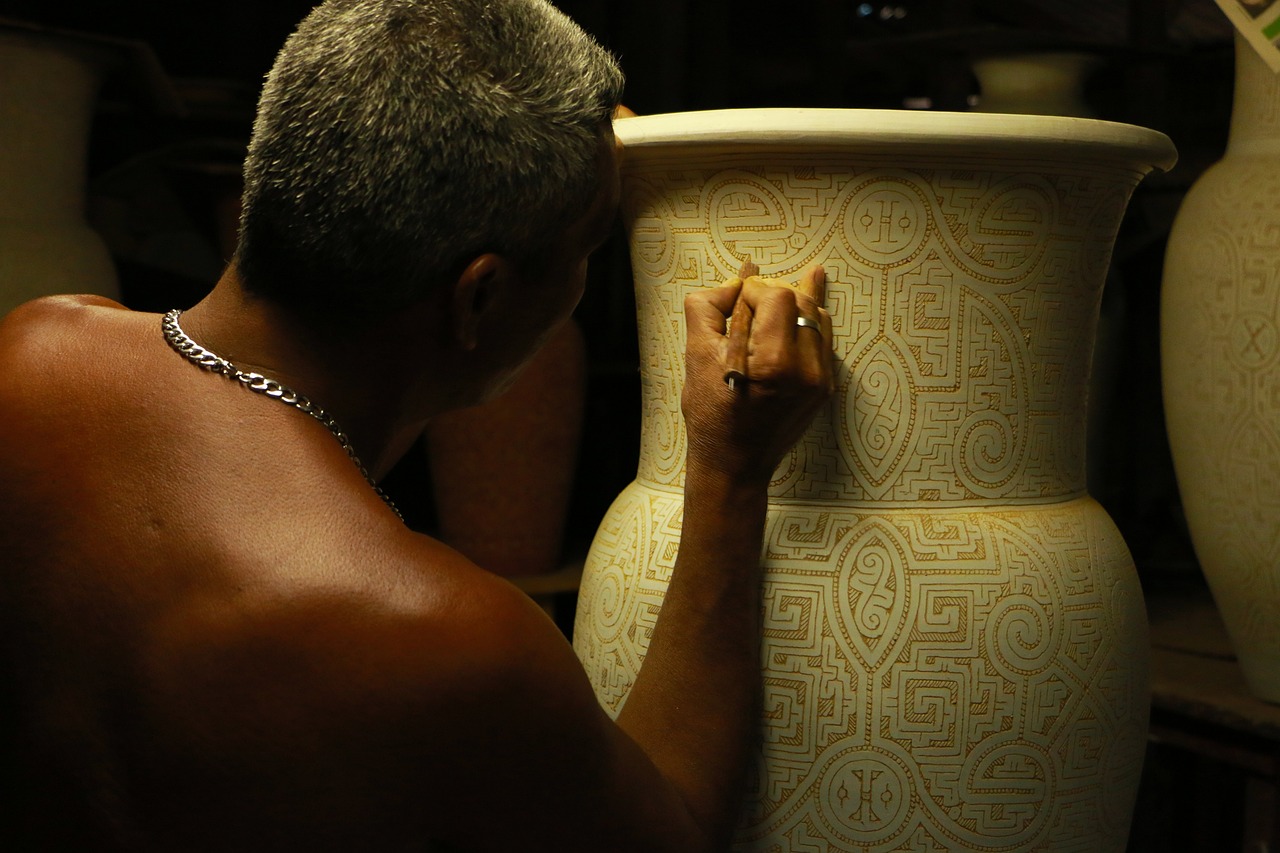
Glazing and Finishing Techniques
When it comes to pottery, glazing is where the magic truly happens. It’s not just about adding color; it’s about transforming your ceramic pieces into stunning works of art. Glazing serves multiple purposes: it enhances the aesthetics, provides a protective layer, and can even affect the texture of your pottery. Imagine holding a beautifully glazed bowl that shines under the light, its surface smooth and inviting. That’s the power of glazing!
Before diving into the glazing process, it’s essential to understand the different types of glazes available. They can be broadly categorized into glossy, matte, and satin finishes. Each type brings its unique flair to your work:
| Glaze Type | Description | Best Used For |
|---|---|---|
| Glossy | Shiny and reflective, enhances colors | Functional ware, decorative pieces |
| Matte | Soft, non-reflective finish, often feels velvety | Artistic pieces, sculptures |
| Satin | A balance between glossy and matte, subtle sheen | Versatile, suitable for both functional and decorative items |
Now, let’s talk about the application techniques. You can apply glaze in several ways, each offering a different result. The common methods include:
- Dipping: Submerging your piece in a glaze bucket for an even coat.
- Brushing: Using a brush to apply glaze, allowing for more control and detail.
- Spraying: Using a spray gun for an even and thin layer of glaze, perfect for intricate designs.
Each method has its pros and cons, and the choice often depends on the specific look you’re aiming for. For instance, dipping is quick and efficient, but it may not allow for intricate designs. On the other hand, brushing gives you precision but can be time-consuming.
Once you’ve applied your glaze, the next step is the firing process. This is where the real transformation occurs. Firing your glazed pottery in a kiln allows the glaze to melt and bond with the clay body, creating a durable finish. It’s like watching a caterpillar turn into a butterfly—what comes out of the kiln can be truly breathtaking!
However, it’s important to note that not all glazes behave the same way in the kiln. Some may change color, while others might react with the clay body. That’s why it’s a good idea to conduct test firings with small samples before glazing your final pieces. This way, you can avoid any unpleasant surprises and ensure that your pieces turn out exactly as you envision.
Lastly, don’t forget about the finishing touches! After your pottery has been fired and glazed, consider techniques like burnishing or adding decorative elements such as underglaze or engobe. These techniques can add depth and character to your pieces, making them truly one-of-a-kind. Remember, the beauty of pottery lies in its imperfections and the personal touch you bring to each piece.
In conclusion, glazing and finishing techniques are essential skills for any pottery enthusiast. They not only enhance the visual appeal of your creations but also ensure their durability. So, roll up your sleeves, get your hands dirty, and let your creativity flow through the art of glazing!
Q: What is the difference between earthenware, stoneware, and porcelain glazes?
A: Each type of clay body interacts differently with glazes due to their composition and firing temperature. Earthenware generally uses lower firing glazes, while stoneware and porcelain require higher temperature glazes for optimal results.
Q: Can I mix different glazes together?
A: Yes, you can mix glazes to create unique colors and effects. However, it’s crucial to test the mixture on a small piece first to see how it reacts during firing.
Q: How do I know if my glaze is food safe?
A: Always check the label or product specifications. Many commercial glazes indicate if they are food safe, but if you're unsure, conducting a test or consulting with a pottery expert is a good idea.

Finding Inspiration for Your Creations
In the world of pottery, finding inspiration is like discovering hidden treasures in a vast ocean. Every piece of clay you touch has the potential to tell a story, and the key is to tap into the wellspring of creativity that surrounds you. Whether you're a seasoned potter or just starting your journey, the quest for inspiration can sometimes feel daunting. But fear not! There are countless sources from which you can draw ideas and motivation for your next masterpiece.
One of the most profound sources of inspiration comes from nature. The organic shapes, textures, and colors found in the world around you can ignite your imagination. For instance, think about the intricate patterns on a leaf, the smooth curves of a river stone, or the vibrant hues of a sunset. Each of these elements can be translated into your pottery designs. Consider taking a stroll through a local park or garden, allowing the beauty of nature to seep into your creative process. You might find yourself inspired to create a collection of vases that mimic the elegance of flower petals or bowls that echo the gentle waves of the ocean.
Another great way to fuel your creativity is by immersing yourself in art and culture. Visit museums, galleries, or even local craft fairs to see what other artists are creating. Pay attention to the different styles, techniques, and materials they use. You might find that a particular color palette or form resonates with you, sparking ideas for your own work. Additionally, exploring art history can provide a wealth of inspiration. From ancient pottery styles to contemporary ceramics, understanding the evolution of pottery can help you find your unique voice within this timeless craft.
Your personal experiences and emotions can also serve as a rich source of inspiration. Reflect on moments that have shaped you—joyful memories, challenging times, or significant milestones. How can these experiences be expressed through your pottery? Perhaps you want to create a piece that represents a cherished memory, using colors and shapes that evoke those feelings. Remember, pottery is not just about creating objects; it's about conveying your story and connecting with others through your art.
Don't underestimate the power of collaboration and community. Engaging with fellow potters can open up new avenues of inspiration. Join a pottery class or participate in workshops where you can share ideas and techniques. Online forums and social media groups dedicated to pottery can also be fantastic places to exchange inspiration. You might discover a new technique or trend that excites you, or even collaborate on a project that pushes your creative boundaries.
Lastly, consider keeping a sketchbook or a journal dedicated to your pottery ideas. Jot down thoughts, doodles, and sketches whenever inspiration strikes. This practice not only helps you remember your ideas but also encourages you to explore them further. You might find that your sketches evolve into full-fledged pottery projects, enriching your artistic journey.
In conclusion, the world of pottery is brimming with inspiration just waiting to be uncovered. By looking to nature, art, personal experiences, community, and keeping a creative journal, you can ignite your imagination and create stunning pieces that reflect your unique perspective. So grab that clay, let your creativity flow, and watch as your ideas transform into beautiful works of art!
- Where can I find pottery classes in my area? Check local community centers, art schools, or pottery studios for classes.
- What materials do I need to start pottery? Basic tools include clay, a potter's wheel (for wheel-throwing), hand tools, and glazes.
- How do I overcome creative blocks? Take breaks, explore new environments, and engage with other artists to reignite your creativity.
- Can pottery be therapeutic? Yes, many people find that working with clay is a great way to relieve stress and promote mindfulness.
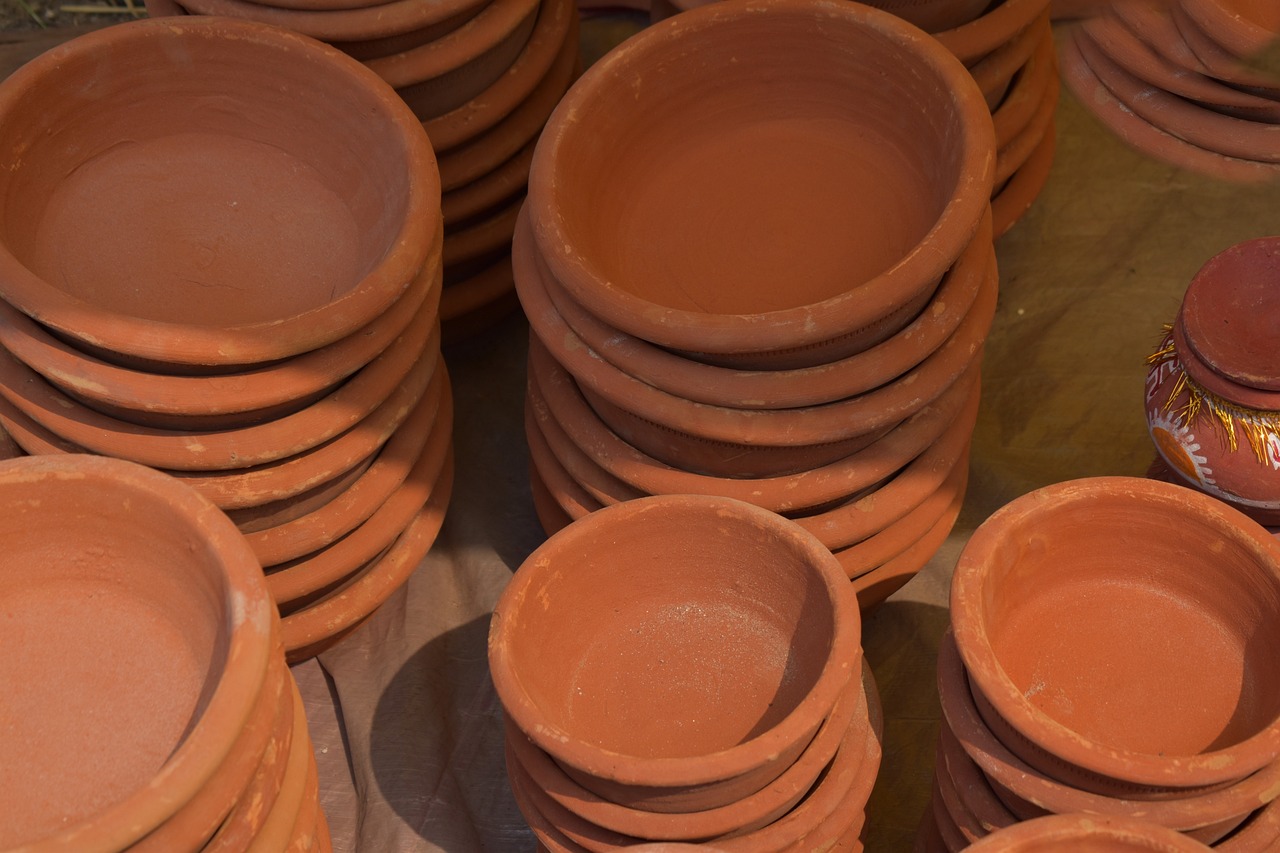
Joining a Pottery Community
Joining a pottery community can be one of the most rewarding steps you take on your artistic journey. Imagine stepping into a vibrant space filled with the smell of clay and the sound of laughter, where creativity flows as freely as the glaze on a freshly thrown pot. Being part of a community not only enhances your skills but also fosters a sense of belonging and shared passion. Whether you're a novice or a seasoned potter, connecting with others who share your enthusiasm can transform your experience in remarkable ways.
One of the greatest benefits of joining a pottery community is the opportunity for collaboration. When you surround yourself with fellow artists, you open the door to new ideas and techniques. You might find inspiration in someone else's work, or perhaps you’ll discover a new method that you never considered before. This exchange of knowledge is invaluable; it’s like having a treasure chest of resources at your fingertips. Plus, working alongside others can push you out of your comfort zone, encouraging you to try new styles and approaches.
Additionally, participating in a pottery community often means access to workshops and classes that might not be available to you on your own. These sessions can range from basic hand-building techniques to advanced glazing methods. Learning from experienced potters can accelerate your growth and help you avoid common pitfalls. Imagine being guided by someone who has spent years perfecting their craft; it’s like having a personal mentor cheering you on!
Moreover, being part of a community provides a support system that can be incredibly beneficial, especially during challenging times. Pottery, like any art form, can be frustrating. There will be moments when your creations don’t turn out as expected. In these times, having friends who understand your struggles can make all the difference. They can offer encouragement, share their own experiences, and remind you that every artist faces setbacks. It’s this camaraderie that can keep you motivated and passionate about your craft.
Another exciting aspect of joining a pottery community is the chance to participate in exhibitions and shows. Many communities organize events where members can showcase their work. This is not only a fantastic way to gain exposure but also to receive constructive feedback from peers and visitors. It’s a thrilling experience to see your creations displayed alongside those of fellow artists, and it can be a huge confidence booster. Plus, you might even make some sales!
In today’s digital age, online pottery communities have also emerged, providing a platform for artists around the world to connect. These virtual spaces allow you to share your work, ask questions, and learn from others without geographical limitations. Whether through social media groups, dedicated forums, or online classes, the internet has made it easier than ever to find your tribe. Just think of it as a global potluck where everyone brings their unique flavor to the table!
In conclusion, joining a pottery community can ignite your creative spark and enrich your artistic journey in ways you might not have imagined. From collaboration and support to learning opportunities and exhibitions, the benefits are endless. So, whether you find a local studio or connect with artists online, take that leap! Your clay awaits, and so does a world of possibilities.
| Question | Answer |
|---|---|
| How do I find a pottery community near me? | You can search online for local pottery studios, community centers, or art schools that offer pottery classes. Social media platforms also have groups dedicated to pottery enthusiasts. |
| Can I join a pottery community if I'm a beginner? | Absolutely! Pottery communities are welcoming to all skill levels. Many members are happy to share their knowledge and help beginners grow. |
| What are the benefits of online pottery communities? | Online communities offer flexibility, access to a wider range of resources, and the chance to connect with artists from around the globe, making it easy to learn and share. |
Frequently Asked Questions
- What types of clay are best for beginners?
For beginners, earthenware and stoneware clays are excellent choices. Earthenware is easy to work with and great for hand-building projects, while stoneware is more durable and can withstand higher firing temperatures, making it perfect for wheel-throwing.
- How can pottery help reduce stress?
Engaging in pottery can be incredibly therapeutic. The tactile experience of molding clay allows you to focus on the present moment, promoting mindfulness and reducing anxiety. It's like a mini-vacation for your mind!
- What essential tools do I need to start pottery?
To kickstart your pottery journey, you'll need a few basic tools: a potter's wheel (if you're wheel-throwing), hand tools like ribs and knives, a rolling pin for slabs, and a kiln for firing your creations. Don't forget a trusty sponge and some water!
- What are some common hand-building techniques?
Common hand-building techniques include pinch pots, where you shape clay with your fingers; coil building, which involves stacking coils of clay; and slab construction, where you roll out flat pieces of clay and assemble them. Each technique offers unique ways to express your creativity!
- How do I master wheel-throwing?
Mastering wheel-throwing takes practice! Start by centering the clay on the wheel, then gradually shape it into your desired form. Watching tutorials and taking classes can be incredibly helpful. Remember, every potter has their own rhythm—find yours!
- What is the importance of glazing in pottery?
Glazing not only adds color and texture to your pottery but also makes it functional by sealing the porous surface. Different glazing techniques can create stunning finishes, making your pieces truly unique. Think of it as the cherry on top of your ceramic creation!
- Where can I find inspiration for my pottery designs?
Inspiration can come from everywhere! Nature, art, personal experiences, and even everyday objects can spark your creativity. Keep a sketchbook handy to jot down ideas or take photos of things that inspire you!
- How can I connect with other pottery enthusiasts?
Joining pottery classes, workshops, or online forums is a fantastic way to meet fellow enthusiasts. Sharing techniques, collaborating on projects, and simply chatting about your love for clay can enhance your creative journey!


















